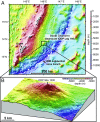Subduction zone forearc serpentinites as incubators for deep microbial life
- PMID: 28396389
- PMCID: PMC5410786
- DOI: 10.1073/pnas.1612147114
Subduction zone forearc serpentinites as incubators for deep microbial life
Abstract
Serpentinization-fueled systems in the cool, hydrated forearc mantle of subduction zones may provide an environment that supports deep chemolithoautotrophic life. Here, we examine serpentinite clasts expelled from mud volcanoes above the Izu-Bonin-Mariana subduction zone forearc (Pacific Ocean) that contain complex organic matter and nanosized Ni-Fe alloys. Using time-of-flight secondary ion mass spectrometry and Raman spectroscopy, we determined that the organic matter consists of a mixture of aliphatic and aromatic compounds and functional groups such as amides. Although an abiotic or subduction slab-derived fluid origin cannot be excluded, the similarities between the molecular signatures identified in the clasts and those of bacteria-derived biopolymers from other serpentinizing systems hint at the possibility of deep microbial life within the forearc. To test this hypothesis, we coupled the currently known temperature limit for life, 122 °C, with a heat conduction model that predicts a potential depth limit for life within the forearc at ∼10,000 m below the seafloor. This is deeper than the 122 °C isotherm in known oceanic serpentinizing regions and an order of magnitude deeper than the downhole temperature at the serpentinized Atlantis Massif oceanic core complex, Mid-Atlantic Ridge. We suggest that the organic-rich serpentinites may be indicators for microbial life deep within or below the mud volcano. Thus, the hydrated forearc mantle may represent one of Earth's largest hidden microbial ecosystems. These types of protected ecosystems may have allowed the deep biosphere to thrive, despite violent phases during Earth's history such as the late heavy bombardment and global mass extinctions.
Keywords: deep biosphere; forearc; serpentinization; subduction zone.
Conflict of interest statement
The authors declare no conflict of interest.
Figures












References
-
- Schrenk MO, Brazelton WJ, Lang SQ. Serpentinization, carbon, and deep life. Rev Mineral Geochem. 2013;75:575–606.
-
- McCollom TM, Bach W. Thermodynamic constraints on hydrogen generation during serpentinization of ultramafic rocks. Geochim Cosmochim Acta. 2009;73:856–875.
-
- Curtis AC, Wheat CG, Fryer P, Moyer CL. Mariana forearc serpentinite mud volcanoes harbor novel communities of extremophilic archaea. Geomicrobiol J. 2013;30:430–441.
Publication types
MeSH terms
Substances
LinkOut - more resources
Full Text Sources
Other Literature Sources
Medical

